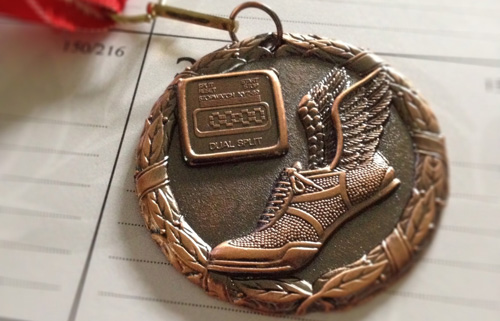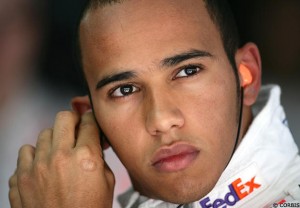
A few weeks ago, I reached one of my goals for 2012, a goal that I have been working on for about a year: I finished a timed 5k in under 30 minutes. If you are a runner you are probably saying “big whoop”‘ but if you know anything about me, you will understand why this is a big deal for me. Continue reading
racing
Last month Runner’s World magazine did its “reader’s issue.” A lot of the stories were about the readers of the magazine instead of the running superstars that are normally featured in the magazine. One reader pointed out that it’s very rare to see a black runner on the cover of the magazine.
The editor talked about this in his monthly address at the beginning of the magazine. Lo and behold, there are mostly white runners featured on the magazine because that’s who is reading the magazine. Nearly 90% of readers are Caucasian, 5.2% are Hispanic and a very low 1.2% are African-American. With 13% of the United State population being African-American, one might hope that might be reflected in running demographics, but it is not. Continue reading
Back in June the awesomely-nicknamed Japanese driver Nobuhiro “Monster” Tajima became the first driver to ever run the Pikes Peak International Hillclimb in under 10 minutes.
The hillclimb is amazingly simple: Try to haul your ass up to the Pikes Peak summit via the partially-paved road, and do it as fast as you can.
Monster broke the record in a 910 hp Suzuki SX4 and his sponsor GoPro, the makers of a line of tiny HD cameras, has put out this incredible video showing the entire run from just about every angle.
Look at your steering wheel. Now look down. Look back up. Your steering wheel is now this thing.
 I’m using an old-ass clichéd joke.
I’m using an old-ass clichéd joke.
This is an Formula 1 steering wheel. It’s used to speak to the pits, adjust break bias, activate turbo boost (I am not kidding), move parts of the car around, even get you a drink. Like almost everything else on an F1 car, it is made of carbon fiber, and is ridiculously expensive. Why carbon fiber? Because it’s light, and absorbs impacts extremely well. The steering wheel has to be able to be removed in five seconds in case of a crash, since the seating area on this thing is so tight, you can’t get in and out with the steering wheel in place.
Here’s an Italian guy explaining how the steering wheel for last year’s Ferrari worked.
http://www.youtube.com/watch?v=T6HFvF-QfTo
Now: all that stuff he said about how KERS (Kinetic Energy Recovery System) isn’t in place anymore, and that makes the wheel easier to deal with? That’s no longer true. KERS is back in this year, in an effort to have more overtaking on the track. Just like in your wimpy Prius, it takes energy released under breaking, and charges a battery with it. That battery can then be accessed to provide 80 more horsepower. You can use it all at once, or gradually over a lap, but once the battery is drained, you have to wait until the next lap to use it again. It was tried in 2009 to extremely mixed results. Ferrari won the Belgian Grand Prix with it, but it also caused a fire in Red Bull’s factory, and shocked a mechanic for BMW Sauber. Bernie Ecclestone, the commercial rights holder for F1 believes that F1 isn’t more massively popular worldwide because there’s not enough passing. That’s a little like saying that soccer (or football, for those of you who actually watch it) isn’t more popular because the total score isn’t higher. As a result, KERS is back in, as is the button that enables it, and the display that shows how much charge you have left.
Also added this year is a moveable rear wing. The button for this opens a flap on the rear wing that stalls it out, reducing downforce, and increasing your straight line speed. This can only be used if you are within one second of the car in front of you, and if you deploy it, the car in front of you cannot. In the first race of the season, no one successfully employed this option to pass anyone, but a few people used it to spin out on turns. So, mission accomplished!
Last year, McLaren employed a genius system to gain more speed on straights. They installed an air intake port in the cockpit that the driver could block with their knee. When blocked, air traveled over the car normally. When opened, air bypassed the rear wing, reducing downforce. Like every genius interpretation of the rules of car construction, this was kept secret until the first race, and then every other manufacturer simultaneously complained it was a breach of the rules, and came up with their own. Ferrari’s required the driver to activate it with his hand, which became a safety issue. While barreling down the track at almost 200 miles per hour, the driver had to take one hand off the steering wheel. This year, drivers are making the same complaint about the steering wheel itself.
There’s so much going on with this year’s wheel, drivers feel they are close to becoming too difficult to operate. Nick Heidfeld feels that the wheels have reached a saturation point, and the fuck up levels are extremely high, while Fernando Alonso thinks that he needs to stop being a pussy.
The argument could be made that if everyone has the same access to KERS, then the average speed of all cars would increase, leveling the field and defeating the purpose. Also, the argument could be made that Sebastian Vettel smoked everyone in Australia without even having KERS installed on his car (this is actually true).
Here’s a link to a detailed explanation on what each button did on BMW’s 2009 wheel. There was no KERS button, because after they shocked a guy, BMW decided not to run it.
Also, here’s another video, this one in English and from Lotus, explaining how their wheel works.
By badhatharry and Daisy Walker
Another F1 season is upon us. If you are one of like three people here who watch it, then you already know this stuff. If you want to learn a bit about the pinnacle in racing, then come on in. I was hoping to get this up before this weekend, but I’m a lazy bastard, so suck it.
The Formula 1 track contains 24 driver, the most of which you don’t really need to know about. The ones who you do, are listed below.
The first multiracial F1 driver, Hamilton was signed to the McLaren youth development program at the age of 13. He made his debut in 2007, finishing second in the World Championship by one point. The following year, he won the title by the same margin in what many claim as the most exciting season finish ever. Has a major rivalry with Alonso, who accused McLaren of favoritism towards then-teammate Hamilton during the 2007 season.
The 2009 World Champion, Button has been a bit of a F1 journeyman until partnering with Ross Brawn at the old Honda team and caught lightning in a bottle. An expert at conserving his tires, Button’s smooth style is a sharp contrast to Hamilton’s aggressive approach, but new teammates’ appear to have a good relationship. Button was the victim of an attempted carjacking/kidnapping/robbery at last season’s Brazilian GP weekend.
Two-time World Champion, Alonso’s aggressive driving style has won him plenty of fans and also many detractors. Controversy has followed him throughout his F1 career, including conflicts with Hamilton, Schumacher and his current teammate Massa. He is often referred to as “the most complete driver on the grid,” but also a driver who will win by any means necessary.
Rebounding strongly from a life-threatening injury at the 2009 Hungarian GP, Massa has finished as high as second in the World Championship (2008). At the 2010 German GP, Massa was involved in the “team orders” controversy at Ferrari when he received instructions from a team engineer that implied he should allow Alonso (ranked higher in points) to pass him. Ferrari were subsequently fined for not following sporting regulations.
Defending World Champion, and at 23, the youngest ever to win the title. Hailed as the “Next Schumacher,” Vettel is now firmly established as the lead driver for his team after some mid-season tension with Webber in 2010.
After 6 years with uncompetitive teams, Webber won his first F1 race in 2009 after joining Red Bull Racing. After leading the Championship for a long period in 2010, he eventually finished the season in third place. Webber crashed spectacularly at the 2010 European GP, flipping his car end over end. He also revealed after the season that he had competed in the final four races with a small fracture in his right shoulder.
Seven time world champion (five of those with Ferrari), the German returned to F1 last year after a three year retirement to join former Ferrari team manager Ross Brawn at the new Mercedes team. Results have been less than stellar, and he’s frequently been outclassed by his younger and less experienced teammate, Nico Rosberg.
In February 2011, Kubica was severely injured in a rally race event, almost losing part of his right arm and hand and requiring four surgeries. His F1 future is uncertain, and Nick Heidfeld will replace him at Renault during Kubica’s recovery.
(everyone give a shout-out to Daisy Walker for writing those driver bios)
The season opener this year is in Australia. It was going to be held in Bahrain, but pick up a paper, and you’ll find out why that didn’t happen. Bernie Ecclestone, the rich Englishman with the mop haircut who owns the commercial rights to the sport, is trying to figure out a way to shove that race in later in the schedule. Bernie is also toying with the ridiculous idea of installing sprinklers on the tracks so if the race is boring, they can turn it into a wet one. The drivers, and everyone else with an IQ above 80, are against this. The tire supplier for this year, Pirelli, supports this idea, because I think they feel it will take focus away from the fact that their tires don’t last very long.
There are two drivers to a team. The drivers race and accumulate points based on what place they take. The points are tallied at the end of the season, and the driver with the most wins the driver’s championship. The points of each driver on a team are tallied, and whichever team has the most between their two drivers wins the constructor’s championship. Last season was Sebastian Vettel and Red Bull, respectively.
That’s it for the overview. We don’t want to hit you with too many facts all at once. This column will either continue throughout the season, or until they stop posting it due to lack of interest. In the next installment, we will discuss the outcome of the Australian GP, and what KERS is and what moveable wings are.








